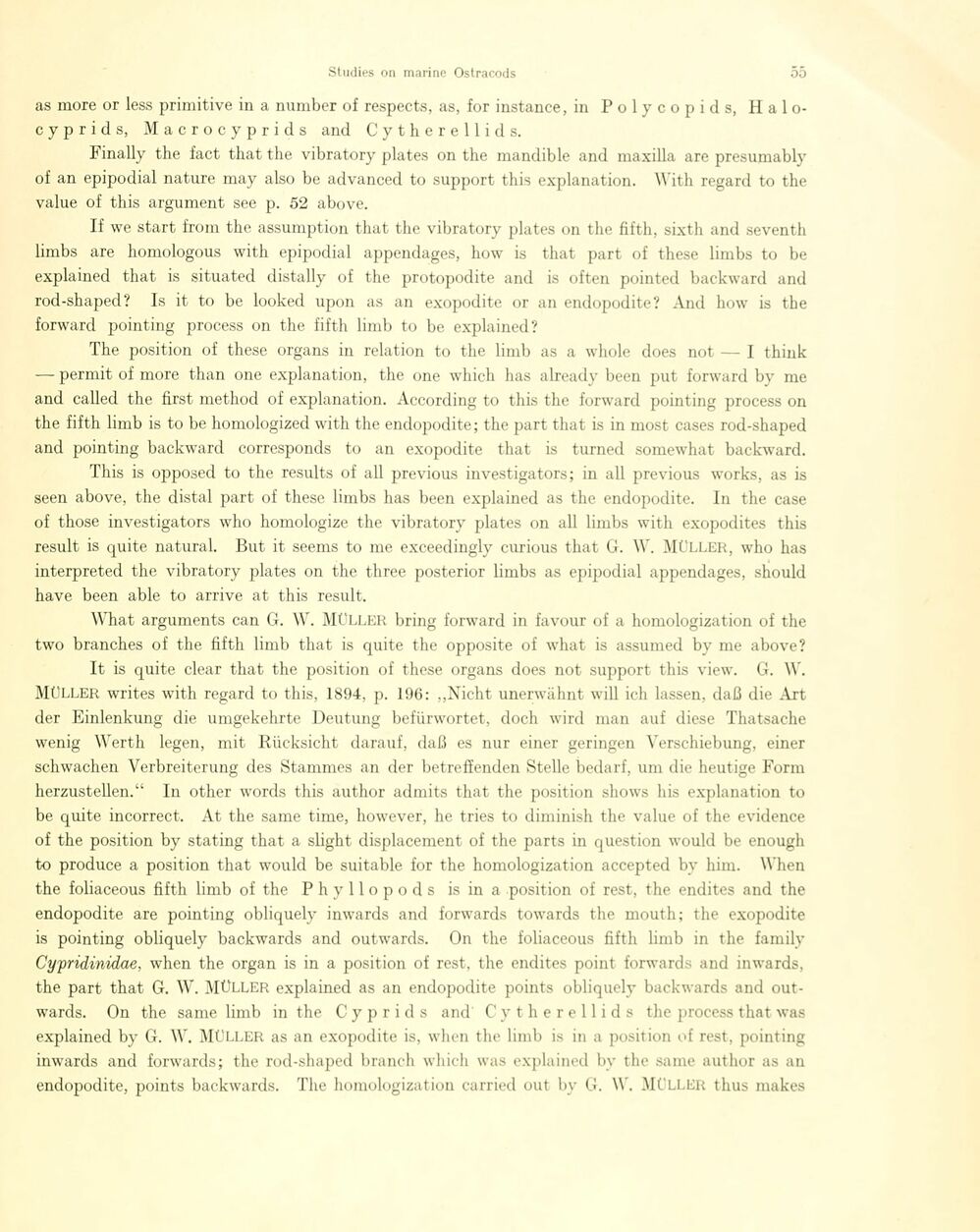
Full resolution (JPEG) - On this page / på denna sida - Sidor ...

<< prev. page << föreg. sida << >> nästa sida >> next page >>
Below is the raw OCR text
from the above scanned image.
Do you see an error? Proofread the page now!
Här nedan syns maskintolkade texten från faksimilbilden ovan.
Ser du något fel? Korrekturläs sidan nu!
This page has never been proofread. / Denna sida har aldrig korrekturlästs.
as more or less primitive in a number of respects, as, for instance, in Polycopids,
Halo-cyprids, Macrocyprids and Cytherellids.
Finally the faet that the vibratory plates on the mandible and maxilla are presumably
of an epipodial nature may also be advanced to support this explanation. With regard to the
value of this argument see p. 52 above.
If \ve start from the assumption that the vibratory plates on the fifth, sixth and seventh
limbs are homologous with epipodial appendages, how is that part of these limbs to be
explained that is situated distally of the protopodite and is often pointed backward and
rod-shaped? Is it to be looked upon as an exopodite or an endopodite? And how is the
forward pointing process on the fifth limb to be explained?
The position of these organs in relation to the limb as a whole does not — I think
— permit of more than one explanation, the one whicli lias already been put forward by me
and called the first method of explanation. According to this the forward pointing process on
the fifth limb is to be homologized with the endopodite; the part that is in most cases rod-shaped
and pointing backward corresponds to an exopodite that is turned somewhat backward.
This is opposed to the results of all previous investigators; in all previous works, as is
seen above, the distal part of these limbs has been explained as the endopodite. In the case
of those investigators who homologize the vibratory plates on all limbs with exopodites this
result is quite natural. But it seems to me exceedingly curious that G. \Y. MÜLLER, who has
interpreted the vibratory plates on the three posterior limbs as epipodial appendages, should
have been able to arrive at this result.
What arguments can G. W. MÜLLER bring forward in favour of a homologization of the
two branches of the fifth limb that is quite the opposite of what is assumed by me above?
It is quite clear that the position of these organs does not support this view. G. W.
Müller writes with regard to this, 1894, p. 196: „Nicht unerwähnt will ich lassen, daß die Art
der Einlenkung die umgekehrte Deutung befürwortet, doch wird man auf diese Thatsache
wenig Werth legen, mit Rücksicht darauf, daß es nur einer geringen Verschiebung, einer
schwachen Verbreiterung des Stammes an der betreffenden Stelle bedarf, um die heutige Form
herzustellen.“ In other words this author admits that the position shows his explanation to
be quite incorrect. At the same time, however, he tries to diminish the value of the evidence
of the position by stating that a slight displacement of the parts in question would be enough
to produce a position that would be suitable for the homologization accepted by him. When
the foliaceous fifth limb of the Phyllopods is in a position of rest, the endites and the
endopodite are pointing obliquely inwards and forwards towards the mouth; the exopodite
is pointing obliquely backwards and outwards. On the foliaceous fifth limb in the family
Cypridinidae, when the organ is in a position of rest, the endites point forwards and inwards,
the part that G. W. MÜLLER explained as an endopodite points obliquely backwards and
outwards. On the same limb in the Cyprids and Cytherellids the process that was
explained by G. W. MÜLLER as an exopodite is, when the limb is in a position of rest, pointing
inwards and forwards; the rod-shaped branch which was explained by the same author as an
endopodite, points backwards. The homologization carried out by G. W. MÜLLER thus makes
<< prev. page << föreg. sida << >> nästa sida >> next page >>